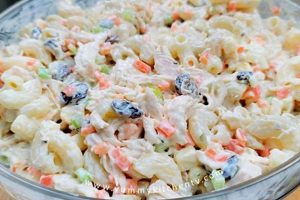A dish featuring cooked chicken combined with mayonnaise, often incorporating celery, onion, and seasonings, enhanced by the addition of cream cheese for a richer, creamier texture and tangy flavor. Variations can include grapes, nuts, or dried fruits. This blend is typically served cold as a sandwich filling, on crackers, or as a salad topping.
The inclusion of cream cheese elevates this classic dish by providing a luxurious mouthfeel and a subtle tang, creating a more complex flavor profile. It also contributes to a smoother, more spreadable consistency. This adaptable dish offers a convenient and protein-rich meal or snack suitable for various occasions, from casual lunches to more formal gatherings. Its historical roots lie in simpler chicken salads, with cream cheese being a later addition that increased its popularity.
This exploration will delve into various aspects of preparing and enjoying this dish, covering topics such as ingredient selection, preparation techniques, serving suggestions, and variations. Nutritional information and potential health benefits will also be addressed.
Tips for a Superior Chicken Salad with Cream Cheese
Achieving optimal flavor and texture requires attention to detail throughout the preparation process. These tips offer guidance for creating a truly exceptional dish.
Tip 1: Chicken Selection is Key: Utilizing high-quality, properly cooked chicken significantly impacts the final result. Roasting or poaching chicken breasts provides optimal flavor and moisture. Canned chicken, while convenient, often yields a less desirable texture.
Tip 2: Cream Cheese Incorporation: Ensure the cream cheese is softened to room temperature before incorporating it into the mixture. This allows for smoother blending and prevents lumps. Gradually fold the cream cheese into the chicken salad to maintain a light and airy texture.
Tip 3: Balancing Flavors: Freshly chopped herbs, such as chives or dill, can elevate the flavor profile. A touch of lemon juice or Dijon mustard adds brightness and complexity. Seasoning with salt and pepper is crucial, but should be done judiciously and tasted throughout the process.
Tip 4: Texture Considerations: Finely dicing the celery and onion creates a more refined texture, whereas larger pieces provide more crunch. Consider the desired consistency when preparing these ingredients.
Tip 5: Chill Time is Essential: Allowing the chicken salad to chill in the refrigerator for at least an hour before serving allows the flavors to meld and the cream cheese to firm up slightly, resulting in a more satisfying experience.
Tip 6: Serving Suggestions: Consider serving the chicken salad on croissants, in lettuce wraps, or as a filling for avocado halves. These options offer appealing presentations and complement the flavors of the salad.
Tip 7: Storage: Store leftover chicken salad in an airtight container in the refrigerator for up to three days. Avoid freezing, as this can negatively impact the texture.
By following these tips, one can create a chicken salad with cream cheese that is both flavorful and visually appealing, enhancing the dining experience.
The following section concludes this exploration with a summary of key takeaways and considerations for customizing this versatile dish.
1. High-quality Chicken
The quality of chicken used significantly impacts the overall taste and texture of chicken salad incorporating cream cheese. High-quality chicken, characterized by a firm yet tender texture and a clean, neutral flavor, provides a robust foundation for the other ingredients to complement. Conversely, chicken that is dry, stringy, or overly processed can detract from the final product, resulting in a less satisfying culinary experience. This difference arises from variations in breeding, feeding practices, and processing methods. For instance, free-range chickens, raised in more natural environments, often yield a more flavorful and succulent meat compared to conventionally raised chickens.
The practical significance of using high-quality chicken becomes particularly evident when combined with the richness of cream cheese. The subtle tanginess of the cream cheese requires a balanced counterpoint, which is best achieved with chicken possessing a clean, natural flavor profile. Imagine using pre-cooked, processed chicken that often contains added salt and preservatives. This can clash with the cream cheese, creating an unbalanced, overly salty final product. In contrast, using freshly roasted or poached chicken allows the cream cheese to enhance the natural chicken flavor rather than compete with it. This distinction highlights the importance of ingredient selection in achieving a well-balanced and flavorful chicken salad.
In conclusion, while convenience might tempt one to opt for pre-cooked or processed chicken, the benefits of using high-quality chicken in a cream cheese-based chicken salad are undeniable. Prioritizing quality ensures a superior taste and texture, allowing the subtle nuances of the cream cheese and other ingredients to shine through, ultimately elevating the dish from simple to exceptional. The investment in higher-quality chicken directly translates to a more enjoyable and satisfying culinary experience.
2. Softened Cream Cheese
Cream cheese, a key ingredient, significantly influences the final texture and flavor profile of chicken salad. Its consistency, particularly whether it’s softened or not, plays a crucial role in achieving the desired smooth, creamy texture that characterizes a well-made chicken salad. Using softened cream cheese ensures proper incorporation and distribution throughout the salad, preventing unwanted lumps or a gritty texture.
- Incorporation and Texture
Softened cream cheese blends seamlessly with other ingredients, creating a homogenous mixture. Cold, firm cream cheese is difficult to incorporate evenly, resulting in lumps and an uneven texture. This smooth incorporation is essential for the creamy consistency characteristic of this type of chicken salad. Attempting to blend cold cream cheese often leads to overmixing the salad, potentially compromising the chicken’s texture and the overall quality of the dish. The softened state allows for a gentle folding action, preserving the integrity of the ingredients.
- Flavor Distribution
Softened cream cheese distributes its tangy flavor more evenly throughout the salad. Cold cream cheese tends to remain in clumps, leading to pockets of intense cream cheese flavor interspersed with areas lacking its presence. This uneven distribution can create an unbalanced flavor profile, detracting from the overall enjoyment of the dish. The uniform distribution achieved with softened cream cheese ensures that each bite contains the desired balance of flavors, enhancing the overall culinary experience.
- Ease of Preparation
Softened cream cheese simplifies the preparation process. It requires less effort to blend and incorporate, streamlining the overall preparation time. This ease of use encourages consistent results and reduces the likelihood of encountering textural issues related to the cream cheese. The reduced effort also allows cooks to focus on other crucial elements of the recipe, such as achieving a balanced flavor profile and ensuring proper ingredient preparation.
- Visual Appeal
Softened cream cheese contributes to a visually appealing chicken salad. A smooth, creamy texture enhances the salad’s aesthetic qualities, making it more appetizing. Conversely, clumps of cold cream cheese can detract from the presentation. The smooth, lump-free consistency achieved with softened cream cheese creates a visually appealing dish that complements its delightful flavor. This attention to detail, even in the cream cheese’s consistency, elevates the entire dining experience.
Softened cream cheese is not merely a convenient shortcut; it is a fundamental element in achieving the desired texture, flavor distribution, and overall quality in chicken salad. Its impact extends beyond simple preparation, influencing the sensory experience of the final dish. By understanding the importance of softened cream cheese, one can elevate a simple chicken salad into a truly exceptional culinary creation.
3. Balanced Seasonings
Balanced seasonings are essential for a successful chicken salad incorporating cream cheese. The richness of the cream cheese and the often-mild flavor of the chicken require careful consideration of complementary flavors to create a harmonious and flavorful dish. Improper seasoning can result in a bland or overpowering taste, diminishing the overall enjoyment. This section explores key facets of seasoning in this context.
- Salt and Pepper Foundation
Salt and freshly ground black pepper form the foundational seasoning elements. Salt enhances the natural flavors of the chicken and other ingredients, while pepper adds a subtle bite. The quantity of each depends on the saltiness of the chicken and personal preference, but moderation is crucial. Over-salting can easily overpower the delicate flavors of the cream cheese, while insufficient seasoning can render the salad bland. Careful tasting and adjustment throughout the preparation process are essential.
- Acidity as a Brightener
Acidity plays a vital role in balancing the richness of the cream cheese. A touch of lemon juice or a dash of white wine vinegar brightens the flavors, preventing the salad from becoming too heavy. The acidity cuts through the richness, adding a refreshing counterpoint. The amount of acid should be carefully calibrated; too much can make the salad overly tart, while too little may not provide the necessary balance. Experimentation and taste testing are key to achieving the optimal level of brightness.
- Herbaceous Enhancements
Fresh herbs contribute depth and complexity to the flavor profile. Fresh dill, chives, parsley, or tarragon, either individually or in combination, complement the cream cheese and chicken. Dried herbs can be substituted if fresh are unavailable, but they should be used sparingly as their flavor is more concentrated. The choice of herbs can significantly influence the final flavor profile; dill offers a slightly tangy, anise-like flavor, while chives provide a subtle oniony note. Selecting herbs that complement personal preferences and the other ingredients is essential for a well-balanced flavor.
- Aromatic Complexity
Finely diced onion or shallot adds a subtle aromatic complexity without overpowering the other flavors. These aromatics provide a depth of flavor that complements the cream cheese and herbs. Garlic, while potentially flavorful, should be used with caution as it can easily dominate the delicate flavors of the chicken and cream cheese. If used, it should be minced very finely and added in small quantities, ensuring its presence enhances rather than overwhelms the overall flavor profile.
Balancing these seasoning elements is crucial for creating a chicken salad that is both flavorful and harmonious. The interplay of salt, acid, herbs, and aromatics enhances the natural flavors of the chicken and cream cheese, creating a complex and satisfying culinary experience. Careful consideration and adjustment of these seasonings allow for customization based on individual preferences and the specific ingredients used, ultimately elevating the dish from simple to exceptional.
4. Optimal Chilling Time
Optimal chilling time plays a crucial role in the final quality of chicken salad incorporating cream cheese. Chilling allows the flavors of the various ingredients, including the chicken, cream cheese, and seasonings, to meld and harmonize. This flavor development occurs as the ingredients interact within the chilled environment, allowing the subtle nuances of each component to emerge and integrate. Without sufficient chilling time, the flavors remain distinct, resulting in a less cohesive and potentially less satisfying culinary experience. For example, a freshly made chicken salad might taste predominantly of cream cheese, with the other flavors playing a secondary role. After optimal chilling, the tanginess of the cream cheese mellows, blending harmoniously with the savory chicken and the chosen seasonings.
The practical significance of this chilling period extends beyond flavor development. Chilling also firms the cream cheese, contributing to the desired texture of the salad. A chilled salad holds its shape better, making it easier to serve and more visually appealing. Furthermore, the colder temperature enhances the refreshing qualities of the salad, making it particularly enjoyable in warmer weather. Consider a scenario where the salad is served immediately after preparation. The cream cheese might be too soft, leading to a less desirable, almost runny consistency. The flavors might also be less pronounced, lacking the complexity that develops during chilling. In contrast, a properly chilled salad offers a firmer texture and a more balanced, nuanced flavor profile.
In conclusion, optimal chilling time is not merely a suggestion but a critical step in achieving a high-quality chicken salad with cream cheese. The benefits extend beyond simple flavor enhancement, impacting texture, presentation, and overall enjoyment. Understanding the importance of this chilling period allows for a more informed approach to preparation, ensuring a consistently delightful culinary outcome. Neglecting this step can compromise the balance and complexity of flavors, ultimately diminishing the potential of this versatile dish.
5. Versatile Serving Options
The versatility of serving options significantly enhances the appeal and practicality of chicken salad prepared with cream cheese. This adaptability stems from the salad’s inherent characteristics: a smooth, creamy texture, a balanced flavor profile, and compatibility with a wide range of complementary ingredients and carriers. This versatility transforms the dish from a simple staple into a culinary centerpiece suitable for various occasions, from casual lunches to elegant appetizers.
Consider the following examples. For a light lunch, the salad can be served within crisp lettuce cups, offering a refreshing and low-carbohydrate option. Alternatively, it can be enjoyed as a sandwich filling, nestled between slices of crusty bread or flaky croissants, creating a more substantial meal. For appetizers, the salad can be presented on crackers or miniature toasts, garnished with fresh herbs or a sprinkle of paprika for an elegant touch. More elaborate presentations might involve stuffing avocados or tomatoes with the salad, adding visual appeal and incorporating additional flavors and textures. This adaptability allows the same base recipe to be transformed to suit different needs and preferences, maximizing its utility.
Understanding the diverse serving possibilities for this dish offers practical advantages. It allows for meal planning flexibility, utilizing readily available ingredients to create a variety of meals and snacks. This adaptability also reduces food waste, as leftover chicken salad can be repurposed in creative ways throughout the week. Furthermore, the diverse serving options cater to a wider range of dietary preferences and restrictions. For example, gluten-free individuals can enjoy the salad in lettuce wraps or on gluten-free bread, while those seeking lower-calorie options can opt for smaller portions served on vegetables. This inherent versatility ensures the dish remains a practical and enjoyable choice for a variety of culinary needs.
Frequently Asked Questions
This section addresses common inquiries regarding chicken salad enhanced with cream cheese, offering concise and informative responses.
Question 1: What type of chicken is best suited for this recipe?
While various chicken types can be used, roasted or poached chicken breasts generally provide optimal flavor and texture. Canned chicken offers convenience, but may result in a less desirable consistency.
Question 2: Can low-fat cream cheese be substituted?
Low-fat cream cheese can be used, but it may alter the final texture and richness of the salad. Full-fat cream cheese offers a creamier, more luxurious mouthfeel.
Question 3: How long can the prepared salad be stored?
Properly stored in an airtight container within a refrigerator, chicken salad with cream cheese typically remains safe to consume for up to three days. Freezing is not recommended, as it negatively impacts the texture.
Question 4: What can be added to enhance the flavor profile?
Fresh herbs such as dill, chives, or parsley can elevate the flavor. A touch of lemon juice, Dijon mustard, or finely diced onion can also add complexity. Consider incorporating dried cranberries, grapes, or chopped pecans for added texture and flavor.
Question 5: Can this salad be served warm?
This salad is traditionally served chilled. Serving it warm is not recommended, as it can negatively affect the texture of the cream cheese and the overall flavor balance.
Question 6: What are some suitable bread options for sandwiches?
Croissants, whole-wheat bread, sourdough, and rye bread all offer excellent bases for chicken salad sandwiches. The choice depends on individual preference and desired flavor combinations.
Addressing these common questions provides a comprehensive understanding of preparing and enjoying chicken salad enhanced with cream cheese. Thoughtful consideration of these points ensures a satisfying culinary experience.
The next section offers a selection of variations on this classic recipe, expanding its culinary possibilities.
Conclusion
Exploration of this dish reveals the interplay of key ingredients and techniques in achieving optimal results. Emphasis on high-quality chicken, softened cream cheese, balanced seasonings, and sufficient chilling time contributes significantly to the final flavor and texture. Versatile serving options further enhance the dish’s adaptability to various occasions and preferences. Understanding these elements allows for consistent preparation and customization, transforming a simple combination of ingredients into a culinary delight.
Culinary exploration extends beyond mere sustenance; it delves into the realm of sensory experience and creative expression. This dish, while seemingly simple, embodies the potential for culinary artistry. Encouraging experimentation with ingredients and presentation elevates the everyday meal into an opportunity for discovery and personal expression. The potential for innovation within this classic combination remains vast, inviting further exploration and refinement.






